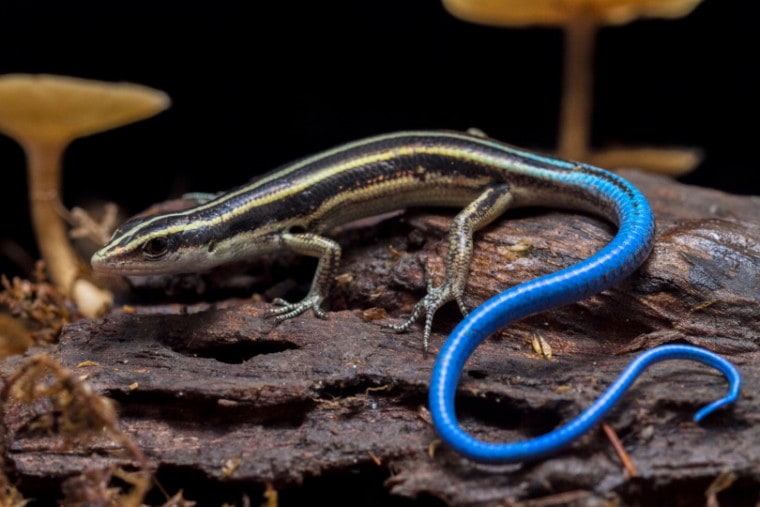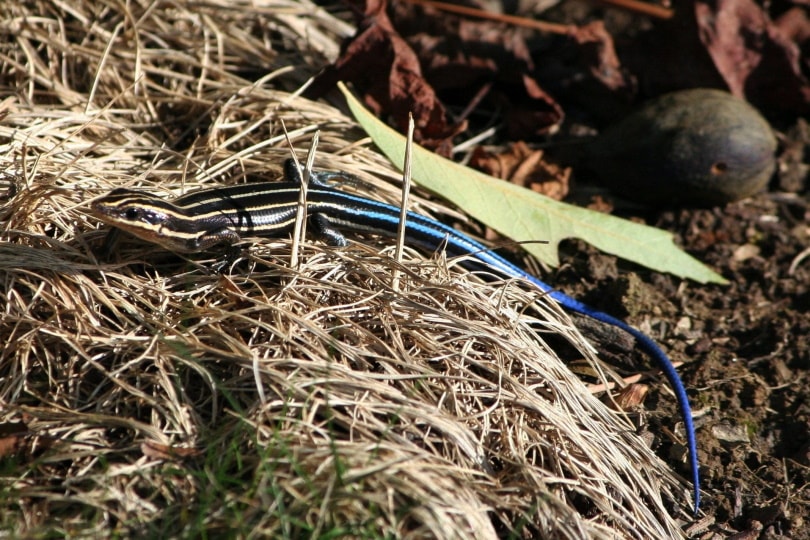
Blue tailed skinks are impressive lizards that love to chow down on a wide array of foods. If you have one of these beautiful lizards at home, what should you be feeding them, and how does that compare to what they eat in the wild? Blue tailed skinks diet consists of mostly insects in the wild.
Furthermore, why should you feed a captive blue tailed skink anything different from what a wild one eats? We break down everything that you need to know about these lizards’ diets here.
 What Do Blue Tailed Skinks Eat in the Wild?
What Do Blue Tailed Skinks Eat in the Wild?

These small critters are primarily insectivores in the wild, but they’re also a bit of an opportunist. Here, we highlighted five different food sources that they’re likely to come across and eat in the wild.
Insects
Almost all of what a wild blue tailed skinks diet consists of is insects. They’re not picky about them either—ants, flies, grasshoppers, crickets, and whatever other insect they can find is what they’ll eat. They also have decent success with mealworms and other small insects that can’t run away that fast.
Arachnids
Did you know that spiders technically aren’t insects? Technically, they’re arachnids, but the blue tailed skink doesn’t seem to mind much when they gobble them down.
- You May Also Like: 11 Largest Spider Species in the World
Lizards
If a wild blue tailed skink comes across a smaller lizard, there’s a good chance that they’ll try to eat it. But this is one food that a wild blue tailed skink eats that you should never feed to your pet skink. The blue tailed skink usually wins the battle, but they often get injured in the process, and over time, those injuries can kill them.
It’s no wonder that a wild blue tailed skink prefers to stick with smaller prey, like insects and arachnids, when possible.
Veggies and Fruits
While wild blue tailed skinks thrive on insects, they can do reasonably well on a heavily plant-based diet too. So, if they’re not catching enough insects in the wild and different fruits and veggies are available, they’ll undoubtedly chow down.
Rodents
While it’s not overly common to see a blue tailed skink eating a small rodent in the wild, it’s mostly because they don’t come across them that often. They don’t go after nesting grounds because there are too many rodents there, but a blue tailed skink can take down a rodent one-on-one in the wild.
What Do Blue Tailed Skinks Eat as Pets?

A blue tailed skink’s diet in captivity is a bit different. That’s because they generally don’t get as much activity, so you need to be more careful what you feed them.
Here, we highlighted 11 different foods that you should include in your skink’s diet.
Fruits and Veggies
Unlike wild blue tailed skinks, we recommend feeding adults up to 70% fruits and veggies. Blue tailed skinks in captivity don’t get as much exercise as wild ones and they get consistent feedings, both of which make them more prone to obesity.
Feed your adult blue tailed skink kale, collard greens, red-tipped apple slices, figs, berries, and the occasional apple slices to keep them happy and healthy. However, if you have a baby or adolescent blue tailed skink, keep them on a protein-strong diet of primarily insects until they’re fully grown.
Silkworms
Silkworms are easy for your blue tailed skink to track down and eat, and they’re full of protein, which helps your skink grow. When your blue tailed skink is an adolescent, feed them a diet of about 70% small insects, a majority of which can be silkworms.
Crickets
Frozen or thawed crickets are excellent options for your blue tailed skink, but ensure that your skink is large enough before feeding them a cricket. Adult blue tailed skinks are more than large enough to take down a cricket, but adolescents and babies aren’t up to the task yet.
Worms
It doesn’t matter which type of worm you feed to your blue tailed skink; they’ll happily gobble it up. Add variety by adding different kinds of worms to keep your skink as happy as possible. Just ensure that you don’t overfeed your skink by giving them worms that are too big.
Centipedes
Another small insect that both baby and adult blue tailed skinks like is the centipede. These insects can come in various sizes, but your skink will break them down into bite-sized portions at meals. Once again, don’t overdo it, though.
Grasshoppers
Just like crickets, your blue tailed skink will love a frozen or thawed grasshopper. Also, you should only feed grasshoppers to an adult blue tailed skink. Otherwise, it’s simply too much food for a baby or adolescent in one go, and it’s harder for them to break it down into smaller chunks.
Spiders
If you have a smaller spider, there’s no reason that you can’t give it to your blue tailed skink for disposal. Just ensure that they’re not venomous and won’t hurt your blue tailed skink. Also, ensure that they’re not too large, especially if your skink is still a baby or an adolescent.
Beetles
Beetles make up over 350,000 known species, and your blue tailed skink will happily gobble down any of them. Just ensure that the beetle you’re feeding your skink isn’t too large and can’t fight back.
Ants
Ants are the perfect food for a baby blue tailed skink. They are extremely small, which makes them easy to eat and digest. Just be sure not to drop a ton of ants in the enclosure at once. If you do, the ants might escape, and you’ll likely have ants running all around your home.
Mealworms
Great tiny insects for both adult and baby blue tailed skinks are mealworms. These have tons of protein, which is essential to your skink’s growth and development. Not only that, but blue tailed skinks also love gobbling down these little worms!
Mineral Supplement
In the wild, a blue tailed skink gets a wide variety of foods to meet all their dietary needs. This is much harder to emulate in captivity. That’s why we recommend adding a mineral supplement to their meal to ensure that they get everything that they need to stay happy and healthy.
 Final Thoughts
Final Thoughts
While blue tailed skinks certainly have a varied diet, this makes them a bit easier to care for. However, you can’t get complacent because captive blue tailed skinks are prone to obesity, and this causes various other health problems.
Be sure to only give them enough food that they can eat in a few minutes and feed them once every few days. This way, you’ll have a healthy blue tailed skink for years to come!
Related Read:
- What Do Blue Tongue Skinks Eat in the Wild And As Pets?
- How Long Do Parakeet Live? Average Lifespan, Data & Care
Featured Image Credit by dwi putra stock, Shutterstock
 What Do Blue Tailed Skinks Eat in the Wild?
What Do Blue Tailed Skinks Eat in the Wild?





